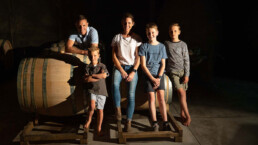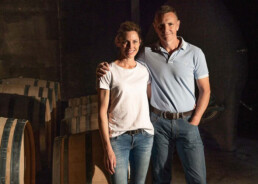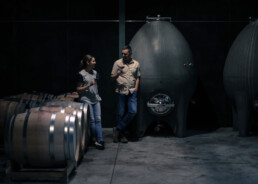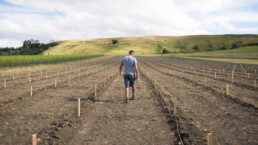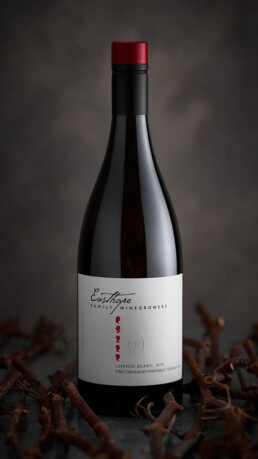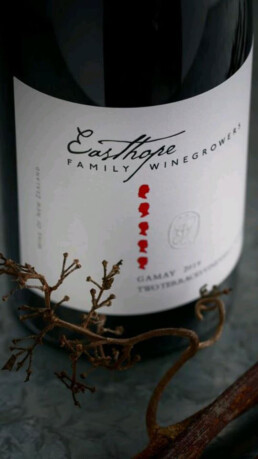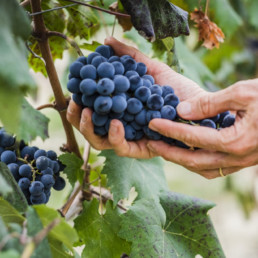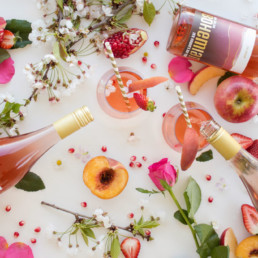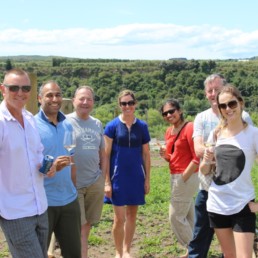It could be said that we are entering an ‘enlightened’ age of smaller being better, artisanal triumphing over industrial, quality over quantity.
At Dhall & Nash, we are very fortunate to have Easthope Family Winegrowers, who embody this hands-on individualistic approach of making terroir-talking wines. Rod and Emma Easthope are crafting small batches of extraordinarily expressive wines showing that, indeed, you can have subtlety with substance.
In the words of winemaker, Rod Easthope:
“Singular wines with an element of profundity are only created through the efforts and skills of vested hands.”
So started this journey towards winemaking idealism. Rod Easthope and his wife Emma are originally Hawke’s Bay locals from vineyard families and they both have some serious national and international winemaking credentials under their belts. Emma has worked at Stonyridge Winery and Martinborough Vineyard. Rod, as Head Winemaker at iconic Craggy Range, was lauded and applauded with rave journalistic reviews, awards, medals and more! Then after the 2012 vintage he gave up the dream job to embark on the next phase of his wine life with Emma and their three young sons. This celebrity winemaking pair wanted to put into practice their overarching philosophies that had eluded them as winery employees in the past.
Basically, that philosophy is to create wines that will not be judged on classically accepted standards, but to tell their unique story from the soil to the bottle. Rod explains his ideas as “the culmination of unmatched viticultural detail and an irreverence for current winemaking convention… We treasure freedom over approval”.
The Terroir
“We tread lightly on our land… whereby viticulture is only a small part of the overall ecology.”
The site they purchased for their new vineyard was 20 hectares overlooking the Ngaruroro River in the Mangatahi district of Hawke’s Bay. Initially 4 hectares were planted in Gamay and Cabernet Franc with 1.5 hectares becoming productive in 2019.
As they await these vines to mature, Rod has been sourcing grapes from a few select vineyards with unique terroir and quality fruit to start the vision that is Easthope Family Winegrowers – crafting sublime wines with minimal intervention.
The Chardonnay is from the legendary Skeetfield Vineyard owned by Denis and Sally Gunn. This treasured site has 25-year-old Mendoza Chardonnay clones. Mr. Chardonnay himself, Tony Bish, also shares some of the fruit from this magical vineyard.
The Two Terraces Vineyard in Maraekakaho, owned by innovative growers Ian and Linda Quinn, is the source of the Chenin Blanc and Gamay Noir fruit.
The Easthope Family Winegrowers 2019 Releases
“In the winery, we only do that which is necessary. This results in wines uncluttered by artefact or fashion. Instead they transparently convey their site and vintage derived character.”
2019 Easthope Family Winegrowers “Skeetfield Vineyard” Chardonnay
As the very eloquent winemaker describes this Chardonnay, “the vinous stars all align on the Skeetfield Vineyard”.
The fruit is 100% Mendoza clone vines planted 25 years ago. The union between the soil, the climate and these mature vines result in grapes that Hawke’s Bay winemakers fight over. The resulting Chardonnay grapes possess considerable flavour and a natural balance that allows Rod to indulge his quest to craft a wine using artisanal techniques.
Hand picking is the crucial starting point, followed by whole bunch pressing which aims to extract not only the juice, but also a high proportion of grape solids. The cloudy juice is then run directly to oak barrels where a natural fermentation occurs – these techniques being crucial to unlocking the mineral and floral elements from the fruit.
Full malolactic fermentation proceeds naturally. Then this Chardonnay spends a total of ten months maturing in barrel and in contact with yeast lees.
As Rod will attest, these old dry-farmed Chardonnay vines just keep delivering unbelievable fruit from year to year. This year it was matured in used French oak puncheons and as a result the oak character is in the background and the virtues of the vineyard are fully expressed.
Tasting profile: Hand Picked, whole bunch pressed, aged for 10 months in used French oak puncheons on yeast lees. The peach, vanilla, subtle oak and bready notes meld for a seamless melange of characters. Classically proportioned Hawke’s Bay Chardonnay showing a rich and long texture with soft acidity.
2019 Easthope Family Winegrowers “Two Terraces Vineyard” Chenin Blanc
The Two Terraces Vineyard is located in Maraekakaho, Hawke’s Bay. The second vintage from this vineyard coincided with fantastic weather conditions.
Chenin Blanc in the Loire Valley of France produces some of the world’s longest-lived white wines. Beginning with focused fruit, florals and laser-like acidity it matures into richly textured and complex wine that retains its fresh acidity into old age.
Bursting with ripe fruits, lifted floral notes and a luscious, yet refreshingly zingy palate – it is the ideal foil to hot days and the alfresco cuisine of summer. The hand picked fruit was 100% whole bunch pressed to yield delicious raw juice which was then fermented with wild yeast in cast stone egg-shaped tanks. The long fermentation and further maturation on the spent yeast lees results in wine where the fruit and floral characters merge with savoury brioche like notes. It’s gloriously delicious.
Tasting profile: Quince, pear, honeysuckle and freshly baked bread notes merge to characterise the aroma. On the palate and luscious mid palate is framed by refreshing natural acidity and a long lingering finish.
2019 Easthope Family Winegrowers “Two Terraces Vineyard” Gamay
This Gamay has developed somewhat of a cult following already – perhaps this will become the Hawke’s Bay’s next rock star grape varietal to rival the burgeoning popularity and reputation of New Zealand Pinot Noir. Let’s hope so as Rod and Emma are already creating magic right here!
This is the first single vineyard Gamay offering from the Quinn’s meticulously managed ‘Two Terraces Vineyard’ in Maraekakaho. The artisanal technique of fermenting as whole bunches with traditional foot stomping, followed by maturation in a combination of seasoned oak puncheons and stone egg tanks has produced a wine with an ethereal combination of fruit, mineral, floral and herbal elements.
Tasting profile: Rose petal, raspberry and forest floor notes combine for a captivating aroma. The palate beguiles with those same characters layered on top of a firm yet velveteen texture.
Needless to say, these compellingly approachable wines all display immense drinkability that is unencumbered by overt winemaking overlay – just as intended under the thoughtful and idealistic guidance of Rod and Emma Easthope.
“Our wines are unburdened by expectation, and instead seek to expose that invisible sensory thread from your glass to our stone laden site.”
Acclaim
Whilst the Easthopes don’t chase validation from wine shows and awards, they nonetheless turn heads and earn themselves raving respect from critics and enthusiasts. This new 2019 release is still very much ‘new’ but previous vintages of these wines give us good indication of where Rod and Emma are taking these tipples.
Joe Czerwinski for Wine Advocate awarded the 2017 Gamay 91 points, and their 2017 Skeetfield Chardonnay 92 points, stating that “…these are raw yet elegant expressions of their grape variety & place”.
From our own shores, Bob Campbell has awarded the 2017 Chardonnay a mighty 94 points, stating “rich & chewy…a complex stylish Chardonnay,” and said that they are a “Hot new Hawke’s Bay winery… like a hot new restaurant that nobody knows about or a newly listed stock that could go sky high.” You can read what Bob wrote on The Real Review here.
Another well-known wine blogger, Jaime Goode (AKA the Wine Anorak), scored the 2015 Gamay 93 points. “Intense and quite powerful… It’s such an interesting wine, with lovely concentration… Ian is currently debating whether or not to plant more Gamay. I urged him to go for it!” You can read his full review here.
Get to know the Easthopes…
Sonja from Dhall & Nash had a wee chat with these Hawke’s Bay heroes and went through the ins and outs of creating these masterpieces. Some quality wine-geek chats ahead, we assure you!
The team at Dhall & Nash is very excited about the new 2019 Easthope Family Winegrowers releases, particularly with the inclusion of the Gamay and Chenin Blanc which are, dare I say, both trending grape varietals in NZ. Firstly, Rod and Emma, you both have some serious winemaking credentials at iconic vineyards in previous lives, Craggy Range, Stonyridge, Martinborough Vineyards – so, what was your impetus and motivation to go it alone to start EFW in 2012?
“We are not great employees! We both loathe meetings, workplace politics and being told what to do. We were both brought up in Hawke’s Bay on family vineyards and witnessed our respective families work hard and weather the vagaries of the seasons – but they were free to chart their own path. I guess that infused us to have similar life goals. We are also control freaks and knew that we could achieve something of consequence in wine if we worked from soil to bottle without delegating anything.”
I love your maxim on your website “Freedom over approval” – can you explain this philosophy further?
“In an age where online likes drive a lot of behaviour, our own experience has made us recognise that seeking someone else’s approval is the path to anonymous mediocrity. The world’s truly fabled wines harness terroir and culture driven idiosyncrasy that would never emerge while trying to appease some third party ideal. Wine Show conformity or mimicking others is a good place for the novice or uninspired to start, but one would hope that the ultimate goal is integrity. This mantra has really allowed us to unveil, what we believe, are compelling elements in our wines.”
You farm organically, do you believe this is a non-negotiable element to where your wines start in the vineyard?
“To be honest, it is not something that we even think about – it just is. We live here, our kids play here, and people drink our wines from here – respecting those things implies we do no harm. Our property is a mix of native bush, livestock, and viticulture. To us it is a single organism of complementary influences where any synthetic intervention would disrupt that natural symbiotic order. Although we are organic, we refuse to certify that. There is already enough mandatory compliance being a wine business, let alone adding another audit to prove to some regulatory body what we and our fans already know to be true.”
Your EFW label is very cool and appropriately textural with the silhouette images of you and your three sons. Was it your own design idea? And apart from dirt bikes in the vineyard, are the boys showing any inclination to help out in the winery?
“We wanted the elements of family, pedigree, and connection to be conveyed on the label in a stylish way. To that end Sara Fraser of Sartoria Creative designed the label that perfectly matched our aims. Sara has that rare knack of listening! And then matching it to her creative talents. We receive a lot of compliments for our label – but all credit to Sara.
Like all young boys, their attention spans are useful for short bursts of work with us in the vineyard and winery. The important thing for us is that they see the whole cycle from working the dirt to tasting our wines with customers, and they make the connection between our land and work with the lifestyle we enjoy.”
Back to the vino – how do you rate the 2019 vintage at EFW?
“It is a superb vintage. A dry summer and autumn ensured concentrated, ripe fruit. Hawke’s Bay has had a great run since the bitterly cold and wet 2012 vintage.”
Dry farming, sustainability, ecological awareness and…? Are there any other viticultural imperatives?
“Only vested hands touch our vines. Our approach is at the individual bud, shoot and bunch level. It is level of attention that could never be achieved through delegation or technology.”
Tell us about your concrete fermenter eggs. Are they a trend or here to stay?
“We love concrete. Our palates over the years have moved away from the seduction and ubiquitous nature of oak. Oak shrouds a wines finest terroir derived features rendering them to be often indistinguishable from all the other oak laden wines made elsewhere. Whereas concrete’s neutrality allows some evolution of the fruit tannins and flavours, whilst not blurring site driven character. Being larger than oak barrels it also means slower development and the retention of the fresher high notes in wines like the floral elements. The egg shape increases the contact of the wine with lees and, when stirred, the lees remain in suspension throughout the wine for longer. This is because there are no corners to interrupt the stir-generated turbulence in the egg. The result is a wine that conserves fresh floral fruit elements and infuses a mineral dimension rather than the foreign and invasive effects of oak.”
Do you have to race Tony Bish to get a share of that exquisite Skeetfield Vineyard chardonnay fruit?
“Ha ha. Tony is a dear friend. And Denis Gunn who owns Skeetfield Vineyard is also a great friend to both of us. We and Tony always thought that 2 or 3 “Skeetfield” labelled Chardonnays from different producers would be a great thing. Very much along the lines of that Burgundy theme, where many producers make wines from the same vineyard. Tony and I have quite differing approaches, so it is a great way to illustrate the human element of terroir.”
What role does whole-bunch pressing and fermentation play in your winemaking methodology? How then does this reflect in the wines?
“All our whites are whole-bunch pressed directly to their fermentation vessel. This approach allows us to control the extraction of solids, phenolics and juice yield. We adjust this for each batch depending on the condition of the fruit and what we tasted in the vineyard when picking. Destemming and/or crushing prior to pressing removes this extraction discretion. Nearly all fine white wines are pressed this way. However, with the reds, we are unusual in that all are fermented as 100% whole bunches. i.e. no destemming at all.
Early in winemaking careers you tend to dabble and experiment. Like try different yeasts, different oak, different maturation regimes etc. And that is the right place to start. But to carve out a unique place in the cluttered world of wine, then confidence in your convictions is required.
Many of the red wines that captivate us from Burgundy, Beaujolais and the Rhone are the producers that employ a 100% whole bunch approach e.g. Dujac, Jamet. And after dabbling with 100% whole-bunch ferments back in 2011 whilst at Craggy Range I knew this is the approach I wanted to take.
In the words of Andrew Jefford; “whole bunch fermentation seems to add an element of profundity”. To us that profundity manifests as a textural dimension that provides depth and line to the mouthfeel of the resulting wine. This sets them apart from their two-dimensional destemmed peers.
Aromatically, whole bunch fermentation can highlight the floral elements of the fruit and infuse a spicy thread. These effects can be polarising and confronting for many imbibers, but we wouldn’t want it any other way.”
Are there any new future projects happening for EFW? Any new grape varieties being planted? Some say Cabernet Franc should be the more widely planted red grape in Hawke’s Bay – what do you think? (We look forward to your Cab Franc bottling soon!)
“We have a young block of Cabernet Franc grown as bush vines and hope to produce our first EFW worthy fruit next vintage. As with the Gamay we envisage an ethereal wine drawing upon Cabernet Franc’s tendency to produce wines with pronounced aromatics. Cabernet Franc is ideally suited to Hawke’s Bay’s climate and soils. For many years Hawke’s Bay has fallen into the ‘bigger is better’ trap and therefore prized Cabernet Sauvignon and Merlot over Cabernet Franc. The virtues of cool climate Cabernet Franc like those from the Loire Valley are a relatively unknown quantity in New Zealand. So, I suspect our version will always be a niche product.
We will also release our first “Home Block” Syrah next year. More about that down the track.”
Gamay Noir seems to be one of the darling grape varieties embraced by natural wine exponents. Has this influenced your style at all? What do you love about working with this grape?
“Gamay lends itself to low intervention winemaking; despite being lighter in style, it is remarkably resilient and retains youthful freshness even in the absence of sulphite preservatives. The fact that nearly all Beaujolais is made with whole bunch fermentation and little oak suggested to us that Gamay not only matched our climate but also matched our style of winemaking. So traditional cru Beaujolais is more of influence than the modern-day trend of “natural winemakers”. We do not think of ourselves as “natural winemakers” – we just happen to farm organically and utilise artisanal techniques. Many in the “natural wine” movement seem to think that this is new, and think that making cloudy, often spoiled wines is some form of virtue. Our belief is that a natural approach and wine purity are not mutually exclusive.”
Do you envisage Gamay and Chenin Blanc being future superstars in the Hawke’s Bay wine region?
“Alternative varieties in the New World always tend to remain just that – alternatives. And that is why we like them. Gamay could be Hawke’s Bay’s answer to challenge or compliment the popularity of Pinot Noir from the southerners. The world’s preference has moved to lighter fresher red wines and Gamay does this well in our temperate climate. But given there is only 7.5ha of Gamay in New Zealand and 5000ha of Pinot Noir then we think it will remain niche for some time yet!
Chenin Blanc has always had a small following thanks to Esk Valley. Chenin Blanc makes some of the longest-lived white wines from Vouvray. Alongside the Loire Valley, South Africa has immense success with Chenin Blanc internationally – so I think that Chenin Blanc has a greater chance for growth as a category.”
Who inspires you in the world of wine?
“I met a remarkable guy called Alvaro Espinoza in Chile. Alvaro and his wife own and run a vineyard/winery called Antiyal. A visit there and spending time with him was the catalyst to do what we are doing now. No one sums up “freedom over approval” more than Alvaro.
Closer to home we have close bunch of independent winemaking friends who we meet with often to chew the fat and share fine wines. These friends challenge, inspire, and support us. Without that connection we may have lost our nerve when encountering the inevitable hurdles while establishing ourselves.”
What do you and Emma like to drink on a quiet night at home?
“We love Champagne, Chardonnay and dry Riesling mostly as the white wine choices. When we splurge, then white Burgundy and Chablis fit the bill. We also love the best Chardonnay wines New Zealand and Australia have to offer.
Red wines tend to be Burgundy, Beaujolais, Northern Rhone and Barolo/Barbaresco – favouring the whole bunch exponents.”
Do you have a vineyard dog?
“No dog but we have native falcons, hawks, kereru, herons, plovers, geese, varieties of ducks, moreporks, pheasants, quail, occasional deer, sheep, cattle, hares, rabbits…”
